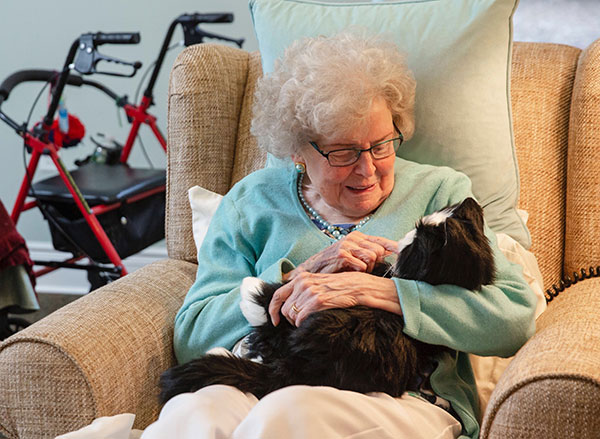You may get a meow, a purr, a roll-over or a blank stare when you pet the robotic cat. And someday soon, it may help connect you with your loved ones.
This week, the Florida Department of Elder Affairs is delivering more than 350 of the Ageless Innovation’s robotic pets to Florida’s socially isolated older adults and adults living with dementia. Earlier this month, the Association on Aging in New York began distributing up to 1,100 robots for the older adults in the state of New York in partnership with Ageless Innovation. Discussions with other states are currently underway.
At least one in seven people with Alzheimer’s in the United States lives alone. While social distancing is crucial for preventing the spread of the virus, it could exacerbate the social isolation for over a quarter of adults ages 50 to 80 who said they felt isolated even before the outbreak. The program’s stakeholders hope the robo-cats and dogs may help mitigate the loneliness of older individuals and adults with dementia during the coronavirus shutdown.
“It’s soothing and calming. It’s not demanding anything of you other than your love and attention. And it’s giving you something in return,” Ageless Innovation co-founder and CEO Ted Fischer told Being Patient in a recent interview.
The cat responds to light and touch. It will meow when you turn the light off. The robot physically vibrates when they purr. The company’s robotic dog, on the other hand, responds to sound and touch. It barks when it hears a human voice — and it even has a heartbeat.
Ageless Innovation’s “Joy for All” line (around $100 to purchase) are part of a growing market for robotic pets. Another canine option is Tombot’s Jennie ($500), a lapdog that barks on command and has hyper-realistic facial features. They get increasingly high-tech and increasingly surreal: PARO ($6,400) is a baby harp seal with tactile sensors and a playful moan; AIBO ($2,900) by Sony is a plastic puppy with glimmering LED eyes and Wi-Fi-capable built-in cameras.
Scientists have found that robotic pets may have proven therapeutic benefits and could serve as a more accessible alternative to traditional pet therapy for people with dementia. While research shows that animal-assisted therapy can reduce their loneliness and relieve their agitation, caring for animals is expensive and requires a great deal of attention. Robotic pets, however, can ease the irritability and apathy of those with dementia according to the research.
The relief they can offer is limited to a potential boost in the the mental state of people with dementia. As the diseases progress however, their positive effects fade, but scientists agree more research is warranted.
According to Claudia Rebola, a researcher and professor at the University of Cincinnati, a yet-to-be-published six-month study of 20 individuals assessed older adults’ relationship to robotic pets. Rebola told Being Patient the preliminary observations show that the older adults in assisted and affordable living are welcoming the robots as companions. The older adults would name their pets and develop a routine with them, understanding they are robotic but treating them as real companions.
“From being a silent community where the hallways were empty, you see older adults coming out of their rooms, walking around and putting the pets on their walkers, talking about their pets and bringing the pets to see other robotic pets,” Rebola said. “The changes are so delightful to see.”
As part of the National Science Foundation-funded research, the team is developing caregiving capabilities for the robots to check the vitals of the users and give daily reminders. They are also developing technology in the robot to connect users with caregivers and loved ones.
“Beyond being a tangible and observable companion that has an impact on the immediate environment of older adults,” said Rebola, “[the robotic pet is] also a simple, intuitive and ‘normal’ entity that serves as an incredible and powerful interface to communicate with older adults and even better, to support an adoption of technology for their health and well-being.”





